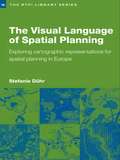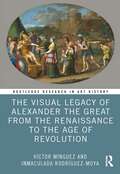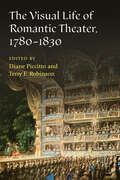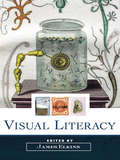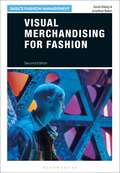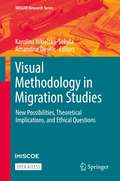- Table View
- List View
Visual Information and Information Systems: Third International Conference, VISUAL'99, Amsterdam, The Netherlands, June 2-4, 1999, Proceedings (Lecture Notes in Computer Science #1614)
by Nies Huijsmans Arnold W. M. SmeuldersThis book constitutes the refereed proceedings of the Third International Conference on Visual Information Systems, VISUAL'99, held in Amsterdam, The Netherlands, in June 1999.The 100 revised papers presented were carefully reviewed and selected from numerous submissions. The book is divided into topical sections on visual information systems, interactive visual query, Internet search engines, video parsing, spatial data, visual languages, features and indexes for image retrieval, object retrieval, ranking and performance, shape retrieval, retrieval systems, image compression, virtual environments, recognition systems, and visualization systems.
The Visual Language of Spatial Planning: Exploring Cartographic Representations for Spatial Planning in Europe (RTPI Library Series)
by Stefanie DührAt a time when strategic spatial planning is undergoing a renaissance in Europe, The Visual Language of Spatial Planning makes a unique contribution to this rapidly growing area of teaching and research. Discussing the relevant theoretical perspectives on policy-making and planning, combined with cartographic communication and the use of cartographic representations in the planning process, Stephanie Duhr provides conceptual and practical tools to help students and practitioners better understand maps and visualizations in strategic spatial planning. The book is the first to review the form, style and use of cartographic representations in strategic spacial plans in the Netherlands, Germany and England as well as at European level. Significant differences between planning traditions and the impact of these on transnational planning processes are highlighted. It concludes by discussing the practical implications for future strategic spacial planning processes in Europe and the best use of cartographic representations to reach agreement and to focus dialogue.
The Visual Language of Spatial Planning: Exploring Cartographic Representations for Spatial Planning in Europe (RTPI Library Series)
by Stefanie DührAt a time when strategic spatial planning is undergoing a renaissance in Europe, The Visual Language of Spatial Planning makes a unique contribution to this rapidly growing area of teaching and research. Discussing the relevant theoretical perspectives on policy-making and planning, combined with cartographic communication and the use of cartographic representations in the planning process, Stephanie Duhr provides conceptual and practical tools to help students and practitioners better understand maps and visualizations in strategic spatial planning. The book is the first to review the form, style and use of cartographic representations in strategic spacial plans in the Netherlands, Germany and England as well as at European level. Significant differences between planning traditions and the impact of these on transnational planning processes are highlighted. It concludes by discussing the practical implications for future strategic spacial planning processes in Europe and the best use of cartographic representations to reach agreement and to focus dialogue.
The Visual Language of Technique: Volume 1 - History and Epistemology
by Luigi CocchiarellaThe book is inspired by the first seminar in a cycle connected to the celebrations of the 150th anniversary of the Politecnico di Milano. "Dealing with the Image Ivory Towers and Virtual Bridges" was the motto of this meeting, aiming to stimulate a discussion among engineers, designers and architects, all of whom are traditionally involved in the use of the Image as a specialized language supporting their work, their research activities and their educational tasks. The book will also include the essays of invited or interviewed authors from other disciplines, namely Philosophy, Mathematics and Semiotics. According to Regis Debray, in the present "Visual Age", which he has significantly defined as a "Video-Sphere", all the information tends to be processed and controlled by means of visual devices. This occurs especially in the various branches of many technical studies and activities, one of the most sensitive areas to the use of Visual Language in the past and even more in the present.
The Visual Legacy of Alexander the Great from the Renaissance to the Age of Revolution (Routledge Research in Art History)
by Víctor Mínguez Inmaculada Rodríguez-MoyaThis is an analysis of the diverse facets of Alexander the Great’s image from the Renaissance era through the Baroque into the nineteenth century. Perceived as the first sovereign ruler of the world, for centuries Alexander became an exemplar for the most ambitious kings and emperors. This cultural phenomenon flourished above all in the Renaissance while extending into the nineteenth century. Early modern monarchs’ identification with Alexander associated them with ideas of kingly wisdom. Yet this admiration waned on occasions. Napoleon was Alexander of Macedonia’s most ardent critic. During the nineteenth century, the Macedonian hero was viewed as an individual who won control of the Achaemenid empire, but also underwent a progressive moral decline that converted him into a tyrant. The book will be of interest to scholars working in art history and iconography.
The Visual Legacy of Alexander the Great from the Renaissance to the Age of Revolution (Routledge Research in Art History)
by Víctor Mínguez Inmaculada Rodríguez-MoyaThis is an analysis of the diverse facets of Alexander the Great’s image from the Renaissance era through the Baroque into the nineteenth century. Perceived as the first sovereign ruler of the world, for centuries Alexander became an exemplar for the most ambitious kings and emperors. This cultural phenomenon flourished above all in the Renaissance while extending into the nineteenth century. Early modern monarchs’ identification with Alexander associated them with ideas of kingly wisdom. Yet this admiration waned on occasions. Napoleon was Alexander of Macedonia’s most ardent critic. During the nineteenth century, the Macedonian hero was viewed as an individual who won control of the Achaemenid empire, but also underwent a progressive moral decline that converted him into a tyrant. The book will be of interest to scholars working in art history and iconography.
The Visual Life of Romantic Theater, 1780-1830
by Diane Piccitto Terry F. RobinsonThe Visual Life of Romantic Theater examines the dynamism and vibrancy of stage spectacle and its impact in an era of momentous social upheaval and aesthetic change. Situating theatrical production as key to understanding visuality ca. 1780-1830, this book places the stage front and center in Romantic scholarship by re-envisioning traditional approaches to artistic and social creation in the period. How, it asks, did dramaturgy and stagecraft influence aesthetic and sociopolitical concerns? How does a focus on visuality expand our understanding of the historical experience of theatergoing? In what ways did stage performance converge with visual culture beyond the theater? How did extratheatrical genres engage with theatrical sight and spectacle? Finally, how does a focus on dramatic vision change the way we conceive of Romanticism itself? The volume’s essays by emerging and established scholars provide exciting and suggestive answers to these questions, along with a more capacious conception of Romantic theater as a locus of visual culture that reached well beyond playhouse walls.
Visual Literacy
by James ElkinsWhat does it mean to be visually literate? Does it mean different things in the arts and the sciences? In the West, in Asia, or in developing nations? If we all need to become "visually literate," what does that mean in practical terms? The essays gathered here examine a host of issues surrounding "the visual," exploring national and regional ideas of visuality and charting out new territories of visual literacy that lie far beyond art history, such as law and chemistry. With an afterword by Christopher Crouch, this groundbreaking collection brings together the work of major art and visual studies scholars and critics to explore what impact the new concept of "visual literacy" will have on the traditional field of art history. Contributors: Matthias Bruhn, Vera Dünkel, Jonathan Crary, Christopher Crouch, Peter Dallow, James Elkins, Henrik Enquist, W.J.T. Mitchell, Richard K. Sherwin, Susan Shifrin, Jon Simons, Barbara Maria Stafford, William Washabaugh
Visual Literacy
by James ElkinsWhat does it mean to be visually literate? Does it mean different things in the arts and the sciences? In the West, in Asia, or in developing nations? If we all need to become "visually literate," what does that mean in practical terms? The essays gathered here examine a host of issues surrounding "the visual," exploring national and regional ideas of visuality and charting out new territories of visual literacy that lie far beyond art history, such as law and chemistry. With an afterword by Christopher Crouch, this groundbreaking collection brings together the work of major art and visual studies scholars and critics to explore what impact the new concept of "visual literacy" will have on the traditional field of art history. Contributors: Matthias Bruhn, Vera Dünkel, Jonathan Crary, Christopher Crouch, Peter Dallow, James Elkins, Henrik Enquist, W.J.T. Mitchell, Richard K. Sherwin, Susan Shifrin, Jon Simons, Barbara Maria Stafford, William Washabaugh
Visual Media Processing Using Matlab Beginner's Guide
by George SiogkasWritten in a friendly, Beginner's Guide format, showing the user how to use the digital media aspects of Matlab (image, video, sound) in a practical, tutorial-based style.This is great for novice programmers in any language who would like to use Matlab as a tool for their image and video processing needs, and also comes in handy for photographers or video editors with even less programming experience wanting to find an all-in-one tool for their tasks.
Visual Merchandising and Display: - with STUDIO
by Martin M. Pegler Anne KongVisual Merchandising and Display, Seventh Edition, focuses on all aspects of visual merchandising and display, from classic techniques to the latest developments. Using hundreds of global examples, this text shows how a retailer can optimize its image with its target market by adding interest to window and interior displays. The book includes updated chapters on lighting, fixtures, and interactive media; expanded sections on store planning, CAD programs, floor plans, and planograms; and a new section called Tools for Getting the Job.New to this Edition:- Contains six new case studies and extensively revised and updated images- New section Tools for Getting the Job in Chapter 27 includes tips for creating your own website and using platforms like Behance to showcase your portfolio -Updated and new Go Green boxes discuss current topics in sustainability and visual merchandising Visual Merchandising and Display STUDIO-Study smarter with self-quizzes featuring scored results and personalized study tips-Review concepts with flashcards of terms and definitions -Watch videos that bring chapter concepts to lifeInstructor Resources -Instructor's Guide with Test Bank provides suggestions for planning the course and using the text in the classroom-PowerPoint® presentations include images from the book and provide a framework for lecture and discussion
Visual Merchandising for Fashion (Basics Fashion Management)
by Sarah Bailey Jonathan BakerWhere do shoppers meet before heading out to browse the stores? Why might they go to a particular shop and not another? What first attracts them to a brand or garment? Visual merchandising is concerned with all these questions, spanning the relationship between consumer, environment, brand and product.As part of the Basics Fashion Management series, Bailey and Baker introduce the principles underpinning successful visual merchandising using examples from budget, mid-range and luxury brands. These real-world examples take the form of detailed case studies and interviews, providing hands-on advice from all levels of industry. This revised edition includes additional coverage of online visual merchandising, lighting techniques, mannequin dressing and integrating technology into displays.
Visual Merchandising Fourth Edition: Window Displays, In-store Experience
by Tony MorganThis comprehensive guide to visual merchandising covers both window dressing and in-store design, as well as all the other elements, real or virtual, used to enhance the contemporary retail experience. Featuring a range of shops, from fashion emporia such as Selfridges, Printemps, and Bergdorf Goodman to small outlets, the book offers practical advice, supported by tips from the most inspiring visual merchandisers and creative directors across the world.It reveals the secrets of their profession and all there is to know about the latest technology, mannequins, props etc. It also examines the psychology and ever-changing trends behind consumer behaviour.Visual merchandising is presented through lavish colour photographs, diagrams of floor layouts and store case studies, and includes invaluable information such as a glossary of terms used in the industry.
Visual Merchandising Second Edition: Escaparates E Interiores Comerciales
by Tony MorganA great introduction for retail students, this book offers a user-friendly reference guide to all aspects of visual merchandising and covers both window dressing and in-store areas. Using examples from a range of shops, from fashion emporia to small outlets, the book offers practical advice on the subject, supported by hints and tips from established visual merchandisers. It reveals the secrets of their toolkit and information on the use of mannequins, the latest technology and how to construct and source props, and explains the psychology behind shopping and buyer behaviour. This new edition contains new case studies and updated images. Presented through colour photographs, diagrams of floor layouts and store case studies, and including invaluable information such as a glossary of terms used in the industry, Visual Merchandising is an essential handbook for anyone working in and learning about this exciting area.
Visual Merchandising Third Edition: Windows, in-store displays for retail
by Tony MorganA great introduction for retail students, this book offers a user-friendly reference guide to all aspects of visual merchandising and covers both window dressing and in-store areas. Using examples from a range of shops, from fashion emporia to small outlets, the book offers practical advice on the subject, supported by hints and tips from established visual merchandisers. It reveals the secrets of their toolkit and information on the use of mannequins, the latest technology and how to construct and source props, and explains the psychology behind shopping and buyer behaviour. This new edition contains two new case studies, updated images and new material on digital and interactive visual merchandising. Visual Merchandising is presented through colour photographs, diagrams of floor layouts and store case studies, and includes invaluable information such as a glossary of terms used in the industry.
Visual Methodology in Migration Studies: New Possibilities, Theoretical Implications, and Ethical Questions (IMISCOE Research Series)
by Amandine Desille Karolina Nikielska-SekulaThis open access book explores the use of visual methods in migration studies through a combination of theoretical analyses and empirical studies. The first section looks at how various visual methods, including photography, film, and mental maps, may be used to analyse the spatial presence of migrants. The second section addresses the processual building of narratives around migration, thereby using formats such as film and visual essay, and reflecting upon the ways they become carriers and mediators of both story and theory within the subject of migration. Section three focuses on vulnerable communities and discusses how visual methods can empower these communities, thereby also focusing on the theoretical and ethical implications of migration. The fourth section addresses the issue of migrant representation in visual discourses. Based on these contributions, a concluding methodological chapter systematizes the use of visual methods in migration studies across disciplines, with regard to their empirical, theoretical, and ethical implications. Multidisciplinary in character, this book is an interesting read for students and migration scholars who engage with visual methodologies, as well as practitioners, journalists, filmmakers, photographers, curators of exhibitions who address the topic of migration visually.
Visual Methods with Children and Young People: Academics and Visual Industries in Dialogue (Studies in Childhood and Youth)
by Eve Stirling Dylan Yamada-RiceThis volume focuses on using visual research methods with children and young people. Featuring insights from academic experts and established professionals from visual industries, it explores a range of issues from visual ethics to children's interaction with place.
The Visual Music Film (Palgrave Studies in Audio-Visual Culture)
by Aimee MollaghanAdopting an interdisciplinary approach, The Visual Music Film explores the concept and expression of musicality in the visual music film, in which visual presentations are given musical attributes such as rhythmical form, structure and harmony.
Visual Notes for Architects and Designers
by Norman Crowe Paul LaseauThe completely updated step-by-step guide to¿capturing experiences in sketch format—regardless of artistic ability Recording your ideas and observations primarily in pictures instead of words can help you become more creative and constructive on the job, no matter what your level of artistic ability. Featuring completely new coverage of visual note-taking in a digital world, Visual Notes for Architects and Designers, Second Edition demonstrates how to make rapid, notational sketches that serve as visual records for future reference, as well as improve understanding and facilitate the development of ideas. It shows you how to expand your knowledge of a subject beyond what is gained through observation or verbal representation alone. You gain access to simple techniques for collecting, analyzing, and applying information. Crowe and Laseau examine the relationship between note-taking, visualization, and creativity. They give practical guidance on how to develop: Visual acuity—the ability to see more in what you experience Visual literacy—expressing yourself clearly and accurately with sketches Graphic analysis—using sketches to analyze observations Numerous examples demonstrate some of the many uses of visual notes. They help you develop a keener awareness of environments, solve design problems, and even get more out of lectures and presentations. The authors also discuss types of notebooks suitable for taking visual notes. If you want to develop your perceptual and creative skills to their utmost, you will want to follow the strategies outlined in Visual Notes for Architects and Designers, Second Edition. It is a valuable guide for architects, landscape architects, designers, and anyone interested in recording experience in sketch form.
Visual Notes for Architects and Designers
by Norman Crowe Paul LaseauThe completely updated step-by-step guide to¿capturing experiences in sketch format—regardless of artistic ability Recording your ideas and observations primarily in pictures instead of words can help you become more creative and constructive on the job, no matter what your level of artistic ability. Featuring completely new coverage of visual note-taking in a digital world, Visual Notes for Architects and Designers, Second Edition demonstrates how to make rapid, notational sketches that serve as visual records for future reference, as well as improve understanding and facilitate the development of ideas. It shows you how to expand your knowledge of a subject beyond what is gained through observation or verbal representation alone. You gain access to simple techniques for collecting, analyzing, and applying information. Crowe and Laseau examine the relationship between note-taking, visualization, and creativity. They give practical guidance on how to develop: Visual acuity—the ability to see more in what you experience Visual literacy—expressing yourself clearly and accurately with sketches Graphic analysis—using sketches to analyze observations Numerous examples demonstrate some of the many uses of visual notes. They help you develop a keener awareness of environments, solve design problems, and even get more out of lectures and presentations. The authors also discuss types of notebooks suitable for taking visual notes. If you want to develop your perceptual and creative skills to their utmost, you will want to follow the strategies outlined in Visual Notes for Architects and Designers, Second Edition. It is a valuable guide for architects, landscape architects, designers, and anyone interested in recording experience in sketch form.
Visual Object Tracking from Correlation Filter to Deep Learning
by Weiwei Xing Weibin Liu Jun Wang Shunli Zhang Lihui Wang Yuxiang Yang Bowen SongThe book focuses on visual object tracking systems and approaches based on correlation filter and deep learning. Both foundations and implementations have been addressed. The algorithm, system design and performance evaluation have been explored for three kinds of tracking methods including correlation filter based methods, correlation filter with deep feature based methods, and deep learning based methods. Firstly, context aware and multi-scale strategy are presented in correlation filter based trackers; then, long-short term correlation filter, context aware correlation filter and auxiliary relocation in SiamFC framework are proposed for combining correlation filter and deep learning in visual object tracking; finally, improvements in deep learning based trackers including Siamese network, GAN and reinforcement learning are designed. The goal of this book is to bring, in a timely fashion, the latest advances and developments in visual object tracking, especially correlation filter and deep learning based methods, which is particularly suited for readers who are interested in the research and technology innovation in visual object tracking and related fields.
Visual Pattern Discovery and Recognition (SpringerBriefs in Computer Science)
by Hongxing Wang Chaoqun Weng Junsong YuanThis book presents a systematic study of visual pattern discovery, from unsupervised to semi-supervised manner approaches, and from dealing with a single feature to multiple types of features. Furthermore, it discusses the potential applications of discovering visual patterns for visual data analytics, including visual search, object and scene recognition. It is intended as a reference book for advanced undergraduates or postgraduate students who are interested in visual data analytics, enabling them to quickly access the research world and acquire a systematic methodology rather than a few isolated techniques to analyze visual data with large variations. It is also inspiring for researchers working in computer vision and pattern recognition fields. Basic knowledge of linear algebra, computer vision and pattern recognition would be helpful to readers.
Visual Peace: Images, Spectatorship, and the Politics of Violence (Rethinking Peace and Conflict Studies)
by Frank MöllerThis book introduces a new research agenda for visual peace research, providing a political analysis of the relationship between visual representations and the politics of violence nationally and internationally. Using a range of genres, from photography to painting, it elaborates on how people can become agents of their own image.
Visual Perception for Humanoid Robots: Environmental Recognition and Localization, from Sensor Signals to Reliable 6D Poses (Cognitive Systems Monographs #38)
by David Israel González AguirreThis book provides an overview of model-based environmental visual perception for humanoid robots. The visual perception of a humanoid robot creates a bidirectional bridge connecting sensor signals with internal representations of environmental objects. The objective of such perception systems is to answer two fundamental questions: What & where is it? To answer these questions using a sensor-to-representation bridge, coordinated processes are conducted to extract and exploit cues matching robot’s mental representations to physical entities. These include sensor & actuator modeling, calibration, filtering, and feature extraction for state estimation. This book discusses the following topics in depth: • Active Sensing: Robust probabilistic methods for optimal, high dynamic range image acquisition are suitable for use with inexpensive cameras. This enables ideal sensing in arbitrary environmental conditions encountered in human-centric spaces. The book quantitatively shows the importance of equipping robots with dependable visual sensing. • Feature Extraction & Recognition: Parameter-free, edge extraction methods based on structural graphs enable the representation of geometric primitives effectively and efficiently. This is done by eccentricity segmentation providing excellent recognition even on noisy & low-resolution images. Stereoscopic vision, Euclidean metric and graph-shape descriptors are shown to be powerful mechanisms for difficult recognition tasks. • Global Self-Localization & Depth Uncertainty Learning: Simultaneous feature matching for global localization and 6D self-pose estimation are addressed by a novel geometric and probabilistic concept using intersection of Gaussian spheres. The path from intuition to the closed-form optimal solution determining the robot location is described, including a supervised learning method for uncertainty depth modeling based on extensive ground-truth training data from a motion capture system.The methods and experiments are presented in self-contained chapters with comparisons and the state of the art. The algorithms were implemented and empirically evaluated on two humanoid robots: ARMAR III-A & B. The excellent robustness, performance and derived results received an award at the IEEE conference on humanoid robots and the contributions have been utilized for numerous visual manipulation tasks with demonstration at distinguished venues such as ICRA, CeBIT, IAS, and Automatica.

